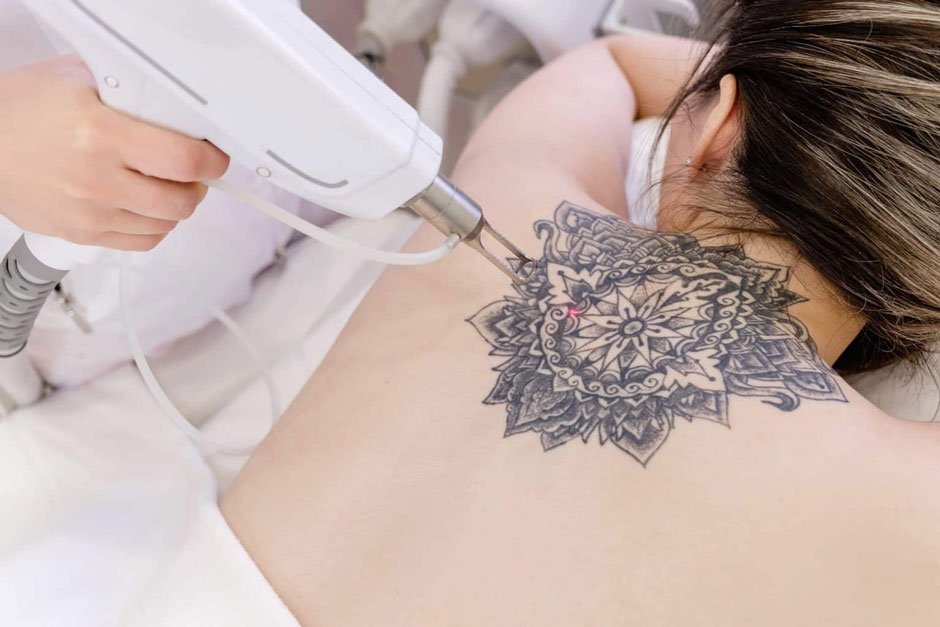 Tattoos have been a form of self-expression, rebellion, and art for centuries. But as permanent as ink may seem, the reality is that life changes, and so do people. The once-beloved design that symbolized freedom at 20 might feel like an anchor at 40. This is where tattoo removal comes in—but if you’ve ever witnessed the grueling process of laser removal, you know it’s no easy feat. It’s painful, expensive, and often leaves behind ghostly traces of ink, a permanent reminder of something meant to be erased.
Tattoos have been a form of self-expression, rebellion, and art for centuries. But as permanent as ink may seem, the reality is that life changes, and so do people. The once-beloved design that symbolized freedom at 20 might feel like an anchor at 40. This is where tattoo removal comes in—but if you’ve ever witnessed the grueling process of laser removal, you know it’s no easy feat. It’s painful, expensive, and often leaves behind ghostly traces of ink, a permanent reminder of something meant to be erased.
However, science is catching up with human nature. The future of tattoo inks is shifting toward designs that embrace both commitment and change—creating inks that allow for easier, faster removal. The idea that a tattoo has to be forever is slowly fading, giving rise to innovations that prioritize flexibility without sacrificing artistry. In this post, we explore how tattoo inks are evolving to meet this demand, the science behind their easier removal, and what this means for the future of body art.
The Evolution of Tattoo Inks
Tattoo ink has come a long way from the crude materials used centuries ago. Traditional tattoo inks are typically made of metal salts, plastics, and other compounds that bind to the skin’s dermis. The very thing that makes them last—large, stubborn ink particles—also makes them a nightmare to remove.
For years, the tattoo industry prioritized vibrancy and longevity over anything else. The thought of “easy removal” was never a consideration because tattoos were meant to be permanent. But as laser removal technology advanced, so did the realization that ink composition played a major role in how efficiently a tattoo could be erased.
In response, a new wave of innovation emerged: organic and plant-based inks. These alternatives, often free from heavy metals, are not only safer for the skin but also more responsive to laser treatments. The pigments break down faster under light exposure, making removal less of a battle.
Now, researchers and tattoo artists alike are embracing the challenge of formulating inks that give wearers more control over their body art. The goal? To create inks that allow for the beauty of a tattoo while ensuring that, should the wearer change their mind, removal isn’t an endurance test of pain and patience.
The Science Behind Easier Removal Inks
Tattoo removal is all about breaking ink particles into small enough fragments that the body can naturally flush them out. Traditional ink particles are large, stubborn, and deeply embedded, requiring multiple laser sessions to break them apart.
Easier-removal inks are designed differently. They incorporate pigments that break down more readily under laser light or natural metabolic processes. Some of the most promising innovations include:
- Biodegradable Inks: These pigments are formulated to fade naturally over time, responding more effectively to the body’s immune system. Some even degrade on their own after a set number of years.
- Light-Sensitive Inks: Certain compounds respond to specific wavelengths of light, allowing lasers to break them down with less intensity and fewer sessions.
- Encapsulated Pigments: These are microscopic ink particles encased in bio-friendly materials that prevent excessive embedding into the skin, making them easier to extract when exposed to laser treatment.
Experts in Houston, TX laser tattoo removal are already seeing the benefits of these advancements, noting that newer ink formulations make the removal process faster and less painful for patients.
Brands and Researchers Leading the Way
A handful of forward-thinking companies are at the forefront of this ink revolution. One of the most well-known pioneers in this space is Ephemeral Tattoo, which has developed a patented ink designed to naturally fade within a year. Unlike traditional ink, which permanently embeds itself into the dermis, Ephemeral’s formula uses a biodegradable approach that allows the body to absorb and eliminate the pigments gradually.
Other brands are working on light-reactive inks that respond specifically to laser wavelengths, reducing the number of sessions needed for complete removal. Some of these formulas have already been tested in clinical settings, showing promising results in both tattoo application and removal.
Dermatologists and laser specialists are also heavily involved in the research. With more precise laser technology and smarter ink formulations, the industry is poised for a future where tattoo removal is no longer a tedious, painful process but a straightforward, predictable one.
The Benefits of Easier-Removal Tattoo Inks
The biggest advantage of these new inks is, of course, the simplified removal process. But beyond that, easier-removal inks offer a range of benefits that extend far beyond convenience.
- Less Pain, Fewer Sessions: Traditional tattoo removal often requires 10 or more sessions, spaced out over months, with each session feeling like a hot rubber band snapping against the skin. Easier-removal inks could cut that number in half or more.
- Reduced Cost: Tattoo removal can cost thousands of dollars, often far exceeding what the tattoo itself originally cost. By shortening the removal process, these inks could significantly lower the financial burden.
- Greater Flexibility for Wearers: Knowing that a tattoo isn’t necessarily forever can encourage more people to explore body art without the fear of lifelong regret. It also opens the door to temporary and semi-permanent tattoo trends that offer commitment-free expression.
- Safer for the Skin: Some of these new inks eliminate heavy metals and toxic compounds found in traditional inks, reducing allergic reactions and long-term skin damage.
Challenges and Concerns
Of course, not everyone is on board with the idea of easier-removal tattoos. Many artists argue that the permanence of tattoos is part of what gives them meaning. If tattoos become as temporary as fashion trends, will they still carry the same emotional and cultural weight?
There’s also the question of durability. While these inks are designed for easier removal, they still need to maintain vibrancy and longevity for as long as the wearer wants them. Striking the right balance between lasting beauty and removable convenience is a challenge that researchers continue to tackle.
Additionally, regulatory approval is a key factor. The tattoo industry remains largely unregulated in terms of ink composition, and new formulations will require rigorous safety testing before widespread adoption.
The Future of Tattoos: A Shift in Mindset?
As tattoo inks evolve, so too does the philosophy surrounding body art. The notion that tattoos must be permanent is fading, replaced by a more fluid approach to self-expression. Just as fashion, hairstyles, and personal styles change, tattoos may one day follow suit—an art form that evolves with the wearer rather than defining them permanently.
For some, this shift is liberating. It allows people to embrace their current passions without the weight of forever attached to their decisions. For others, it threatens the sacred permanence of tattoo culture, an art form rooted in history and commitment.
But whether you see it as an advancement or a betrayal of tradition, one thing is certain: the future of tattoo inks is more dynamic than ever. The choice to keep a tattoo forever or remove it effortlessly is becoming a personal decision rather than a biological limitation.
Conclusion
Tattoos have always told stories—of identity, rebellion, love, loss, and everything in between. But those stories evolve, and now, the ink that writes them can, too. With advancements in ink technology, we are entering an era where tattoos no longer have to be a life sentence.
The beauty of body art should lie in its ability to reflect who we are in the moment, without the fear of regret. As the science of tattoo inks advances, it offers more freedom, more choice, and a future where tattoos are not just a commitment but an adaptable form of self-expression.
So, is the future of tattoos about permanence or change? The answer is both. And that’s the most exciting part.





Leave a Reply